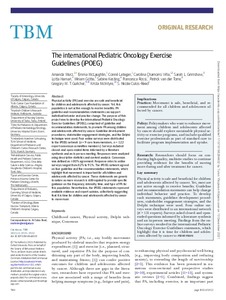The international Pediatric Oncology Exercise Guidelines (iPOEG)
Wurz Amanda; McLaughlin Emma; Lategan Conné; Viña Carolina Chamorro; Grimshaw Sarah L; Hamari Lotta; Götte Miriam; Kesting Sabine; Rossi Francesca; van der Torre Patrick; Guilcher Gregory MT; McIntyre Krista; Culos-Reed S Nicole
https://urn.fi/URN:NBN:fi-fe2022012710594
Tiivistelmä
Physical activity (PA) and exercise are safe and beneficial for children and adolescents affected by cancer. Yet, this population is not active enough to receive benefits. PA guideline and recommendation statements can support individual behavior and practice change. The purpose of this project was to develop the international Pediatric Oncology Exercise Guidelines (iPOEG), comprised of guideline and recommendation statements, to promote PA among children and adolescents affected by cancer. Guideline development procedures, stakeholder engagement strategies, and the Delphi technique were used. Four online surveys were distributed to the iPOEG network (n = 9 core team members, n = 122 expert consensus committee members). Surveys included closed- and open-ended items informed by a literature synthesis and an in-person meeting. Responses were analyzed using descriptive statistics and content analysis. Consensus was defined as >= 80% agreement. Response rates to online surveys ranged from 82% to 91%. The iPOEG network agreed on four guideline and five recommendation statements, which highlight that movement is important for all children and adolescents affected by cancer. These statements are generic in nature as more research is still required to provide specific guidance on the frequency, intensity, time, and type of PA for this population. Nevertheless, the iPOEG statements represent available evidence and expert opinion, collectively suggesting that it is time for children and adolescents affected by cancer to move more.
Kokoelmat
- Rinnakkaistallenteet [27094]
